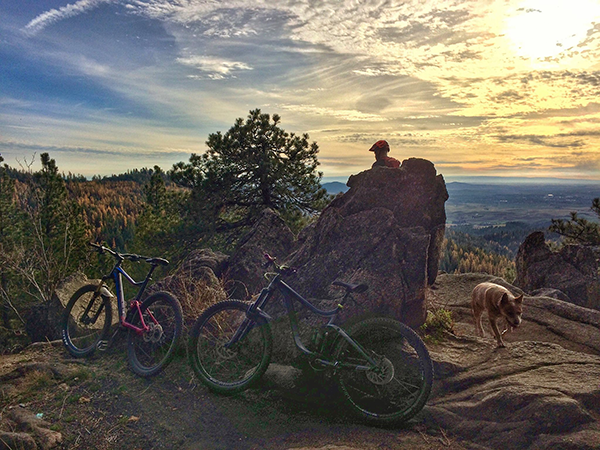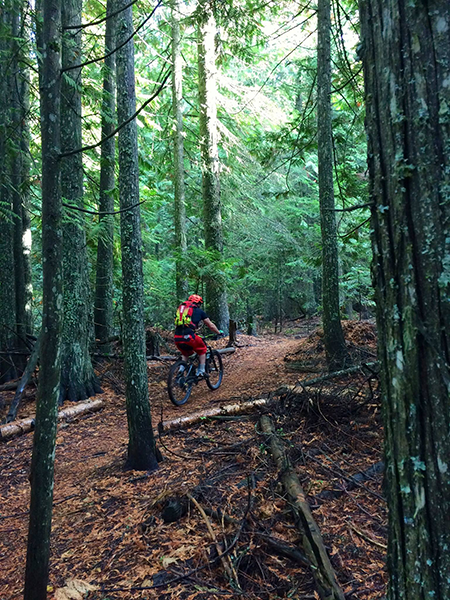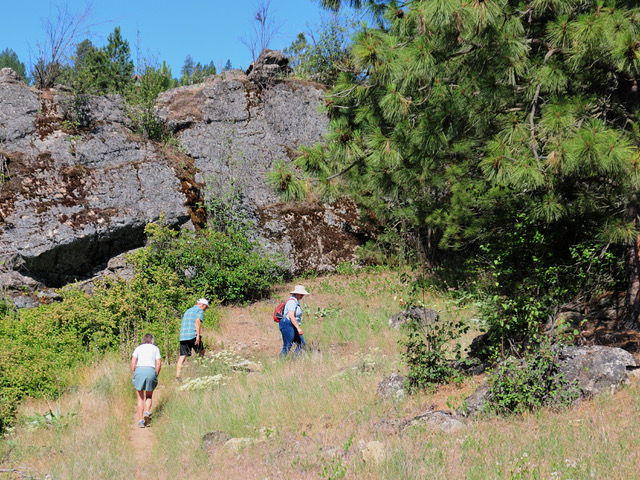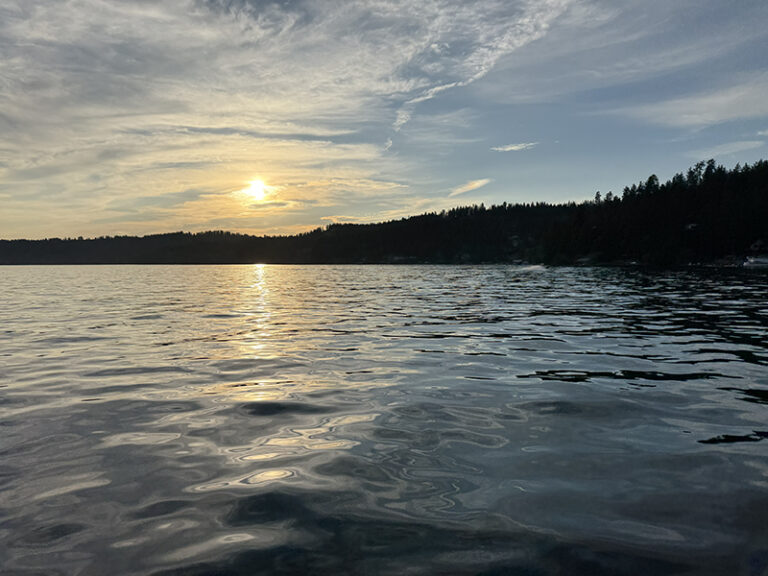If you’ve ever been to Moscow, Idaho, you’ve seen it. And if you’ve lived there, you’ve probably been on it.
Moscow Mountain—a long, 5,000-foot-high ridge rising from a sea of rolling hills—dominates the Palouse skyline. During the summer, mountain bikers, hikers, and equestrians enjoy over 70 miles of trail on the mountain’s flanks. In the winter, backcountry skiers and snowshoers take their turn enjoying the mountain’s charms.
You might be tempted to thank the people who set the area aside, those forward-thinking individuals who oh-so-long-ago preserved the mountain for the public to enjoy in perpetuity. You might be tempted to hold up the mountain as an example of public land done right, a place where the will of the people won out against corporate interests. You might be tempted—and you’d be wrong.
In fact, very little of Moscow Mountain is public. With a few small exceptions, the mountain lies in private hands. The story of Moscow Mountain isn’t one of government regulation or environmental activism. It’s better than that. It’s a story of cooperation, of mutual trust and respect. Ultimately, it’s a story about an Idaho logger who wanted to protect his family’s livelihood—and the local mountain biker who could make it happen.
Like many good stories, this one begins in the 90’s. The scene on Moscow Mountain was a lot different back then. For decades, local residents had been using the area as a trash dump. Garbage—from beer cans and candy wrappers to washing machines and rusted cars—littered the slopes. Partiers from the University of Idaho and Washington State frequented the area on the weekends, leaving broken glass and smoldering fire rings in their wake. Illegal firewood collecting was taking its toll on the mountain’s trees. Worst of all, overuse by motorcycles and four wheelers on the mountain’s network of old logging roads resulted in massive problems with erosion.
“Four wheelers and mud boggers were tearing the shit out of the mountain,” remembers Brett Bennett of Bennett Lumber, the mountain’s largest landowner. “They’d turn a puddle into a giant hole.”
Erosion was a particular problem due to a court-issued mandate to clean up Paradise Creek, which drains the western portion of Moscow Mountain. Poorly constructed roads and trails were being beat to death by unsanctioned motorized use, causing extreme amounts of sediment to get washed into the creek. During heavy rain, the creek looked more like chocolate milkshake than a pristine mountain stream. As a consequence, much of it had become ecologically sterile.
Something had to be done, but Bennett’s resources were limited. “We’re just small potatoes, a small family timber operation. Not like a huge corporation who could probably hire their own cop to watch over things,” Bennett remarks.
Bennett’s solution came to him in a chance encounter with Jim LaFortune, a science teacher at Moscow’s junior high school and an enthusiastic mountain biker. LaFortune was the president of the Moscow Area Mountain Bike Association (MAMBA) and had been riding old skid roads on the mountain for years. He even authored a local guidebook, “Mountain Bike Guide to Hog Heaven,” in 1995.
The two individuals came from different worlds, but they saw an opportunity for a mutually beneficial relationship. If LaFortune and his mountain bikers could police the mountain, Bennett reasoned, then vandalism and property damage might be avoided. If Bennett gave official recognition to the mountain bikers, LaFortune surmised, there could be opportunities for more and better trails.
It all came to a head at a March 2002 meeting in the 1912 Center near Moscow’s downtown. A diverse assortment of user groups—mountain bikers, four-wheel drive enthusiasts, skiers, hikers, snowmobilers, and horsemen—attended the meeting, in addition to several landowners, including Bennett.

The user groups discussed how and where they recreated. The landowners described their problems with vandalism and misuse. In the end, everyone seemed to agree on a basic point: Moscow Mountain was too important to the community to be cut off entirely, but there had to be rules which protected landowner rights.
After the meeting, an informal management plan for the mountain began to congeal. While most large-scale land management plans start at the top, this one was conceived at the grassroots. It was a plan crafted not by lawyers and government bureaucrats but by local citizens. Although the plan banned motorized use, biking and other non-motorized use was allowed to persist, provided that visitors cooperate with local landowners.
“The mountain bikers weren’t really hurting anything,” Bennett reasoned. Keeping people off the mountain altogether was a losing proposition, he figured, given the longstanding precedent of allowing public access on the mountain. And if people were going to be there, he might as well pick who they were.
LaFortune and his crew of bikers got to work immediately, providing Bennett’s foresters with information on trail conditions and locations. “They had a few trails that no one knew about ‘til the meeting,” Bennett remembers. “They GPS’d them and gave us the information.” Once Bennett knew the locations of the trails, he could communicate with MAMBA to alert them whenever one of their trails fell within a timber harvest so they would know to steer clear.
Not only did MAMBA work with Bennett’s foresters to map and build new trails, but they also invested significant time and effort in returning the mountain to a better state. Garbage was removed in droves. Motorcyclists who violated the motorized ban were educated. Trails were rerouted and reconstructed to prevent erosion.
Scott Metlen, a business professor at the University of Idaho and current president of MAMBA, recalls the shift in the mountain’s atmosphere. “When I got here in ’01, there were garbage piles everywhere. We have slowly cleaned up the mountain, and people don’t drop their garbage there anymore. We’ve taken some of their logging roads and made it so there’s no run-off. Every year we re-route a section of trail so there’s no runoff. We build them so they don’t wash.”
Monthly newsletters sent to MAMBA’s membership stressed the importance of mountain stewardship and reflected LaFortune’s own humorous, charismatic personality. One such bulletin reads: “If you see ATVs or motorcyclists off the main roads, feel free to remind them (assuming they’re sober and gun-free) that the mountain is essentially all private land and that they are only allowed on the main roads.”
Another continues: “In a few weeks, I’ll be sending an email to you containing the names and street addresses of a few of our key landowners. It would be terrific if a few thankful community members who use the trails (i.e.; YOU), would write a short personal note expressing appreciation for the privilege of using these private lands for our re-creation.”
This was typically followed by one of LaFortune’s trademark closing phrases: “Put the power to the pedal,” “Rubber side down,” or “Don’t happy, be worried,” before he signed off.

Although MAMBA enjoyed its newfound legitimacy, emerging from the shadows came with its share of growing pains. Bennett Lumber is the largest landlord on the mountain, and every trail either crosses or is accessed from Bennett property. Still, it’s not the only game in town. And although MAMBA has cooperative agreements with nearly 30 individual landowners, some did not share Bennett’s obliging attitude after being informed of trails on their property. Metlen recalls several instances of having to remove existing trails and structures due to landowner opposition.
“Some of the landowners have gotten pretty pissed,” notes Bennett, adding that the relationship with recreationalists hasn’t always been rosy. “Some people have taken equipment for a joy ride and thrown it over a ravine. We’ve had some frustrations. We’ve come close a few times to just nuking the whole idea. But it’s been mostly positive.”
For Bennett, the benefits provided by the trail users outweigh the costs. On several occasions, bikers have helped prevent a potentially catastrophic disaster. “Mountain bikers will contact us and say ‘Hey, we found a campfire and put it out,’ or ‘We called the fire department,’” Bennett explains. For a man that depends on intact timberland for his livelihood, the detection of unwanted fires is a priceless service.
“We’ve put out several different fires as a group. They like us being up there because we inform people of their rules and we follow their rules. It has turned out to be a pretty good symbiotic relationship,” Metlen claims, before ending with a caveat. “But as with any relationship, it could go south pretty easily.”
In 2009, Moscow’s mountain biking community was called upon to attend to a different sort of fire. In September of that year, Jim LaFortune had a tumor removed from his brain. Two months later, the community came together to host a benefit dance and auction to help cover his medical expenses. As revelers danced the night away, donations and bids poured in. By the time the evening ended, over $36,000 had been raised.
LaFortune passed away nearly a year later, at the age of 51. A few weeks before he died, as the disease slowly ate away at his memory and stamina, LaFortune mustered himself for one last ride with the people he loved on a new trail with a very special name. It is, fittingly, LaFortune’s Flight.
That’s the beauty of the trails on Moscow Mountain: they remind you where they came from. One trail is called Private Lands, in tribute to landowners like Brett Bennett who were gracious enough to offer up their property for all to enjoy. A second trail honors the man whose sweat and tenacity brought the whole thing into being. Next time you’re in the Moscow area, be sure to stop by and enjoy it. Whether you’re on two wheels or two feet, I guarantee you’ll appreciate its swooping turns, plunging dips, and smooth dirt tread. As you weave your way beneath the evergreen boughs of grand fir and white pine, stop and take a moment. Breathe a breath. Eat a huckleberry. Listen to the trickle of a mountain stream. Then, when you’ve had your fill, offer up a quick thank-you to the people who made it all possible.













